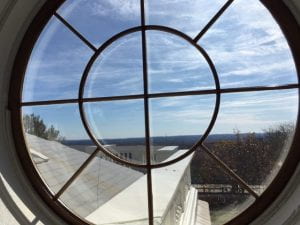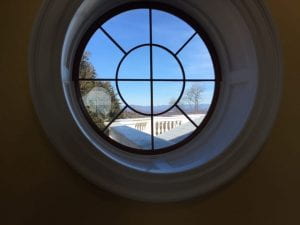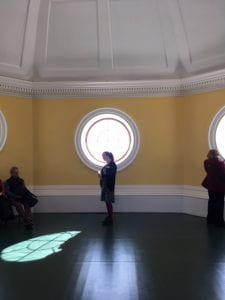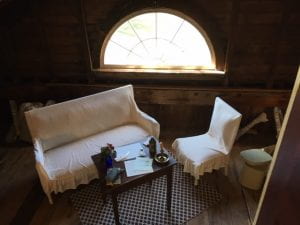Thomas Jefferson’s painstakingly-constructed home perches atop a small mountain (“monticello”) looking out into the Blue Ridge range in central Virginia. You ascend to, and park at, the Visitor’s Center to board a shuttle and ascend another steep road to the impressive edifice resembling the grandeur of the Italian Renaissance. If you pause to survey the horizon, you get the feeling of being on top of the world with the distant mountains as the only limit.
We were not allowed to take pictures except in the Dome, but you can see the furnished rooms at https://www.monticello.org/house-gardens/the-house/room-furnishings/.
The design was conceived in 1769, but the work was interrupted during Jefferson’s foreign service in France following his wife’s death (1784-89). His fascination with all things French influenced his conception of the house and he began to reconstruct the second level soon after he returned home. Because he tore down the second floor of the first structure, it is sometimes known as Monticello I and Monticello II.
The main structure was completed in 1801, but Jefferson added pavilions at the four corners of the building until 1808. An outline of the amazing evolution of Monticello is captured on the website:
1768 Mountaintop cleared and leveled
1769 First bricks made and construction begun
1770 Jefferson moved into the completed South Pavilion
c. 1772 Dining Room (north wing) is the first part of the house
to be completed and made habitable
1796 Demolition of upper story and construction
based on new design begun
1801-03 North Terrace, South Terrace, and dependencies built
1806 North Pavilion under construction
1808 North Pavilion completed and South Pavilion remodeled [top]
What you learn from the design and furnishings of Monticello was that Jefferson was interested in every subject of living from cooking to waste disposal to heating and ventilation to gardening to weather to music and art. He wrote endlessly on these subjects and left his thoughts to posterity. He only destroyed the letters he wrote to Martha Wales Skelton, his wife, upon her death. He wrote about the rights of African slaves to be free, but negotiated the freedom of only seven of his hundreds of slaves. He regretted that many of his slaves would have to be sold to pay his indebtedness, which is estimated at $107,000 at his death.
Thomas Jefferson died on July 4, 1826, a coincidence he relished. John Adams died the same day.
You can see a timeline of Jefferson’s life at https://www.monticello.org/jefferson-timeline/






